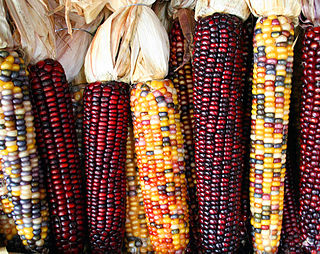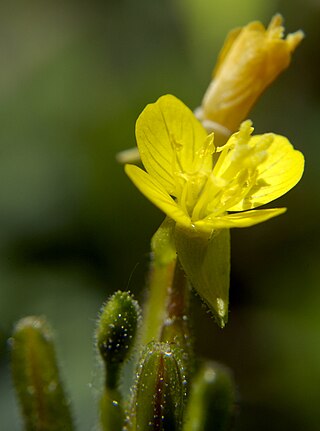
Zea is a genus of flowering plants in the grass family. The best-known species is Z. mays, one of the most important crops for human societies throughout much of the world. The four wild species are commonly known as teosintes and are native to Mesoamerica.

Bellis is a genus of flowering plants in the family Asteraceae.

Lupinus, commonly known as lupin, lupine, or regionally bluebonnet etc., is a genus of plants in the legume family Fabaceae. The genus includes over 199 species, with centers of diversity in North and South America. Smaller centers occur in North Africa and the Mediterranean. They are widely cultivated, both as a food source and as ornamental plants, but are invasive to some areas.

Bellis perennis, the daisy, is a European species of the family Asteraceae, often considered the archetypal species of the name daisy. To distinguish this species from other plants known as daisies, it is sometimes qualified as common daisy, lawn daisy or English daisy.
Sarcocornia is a formerly recognized genus of flowering plants in the amaranth family, Amaranthaceae. Species are known commonly as samphires, glassworts, or saltworts. Molecular phylogenetic studies have shown that when separated from Salicornia, the genus is paraphyletic, since Salicornia is embedded within it, and Sarcocornia has now been merged into a more broadly circumscribed Salicornia. When separated from Salicornia, the genus has a cosmopolitan distribution, and is most diverse in the Cape Floristic Region of South Africa.

A botanical name is a formal scientific name conforming to the International Code of Nomenclature for algae, fungi, and plants (ICN) and, if it concerns a plant cultigen, the additional cultivar or Group epithets must conform to the International Code of Nomenclature for Cultivated Plants (ICNCP). The code of nomenclature covers "all organisms traditionally treated as algae, fungi, or plants, whether fossil or non-fossil, including blue-green algae (Cyanobacteria), chytrids, oomycetes, slime moulds and photosynthetic protists with their taxonomically related non-photosynthetic groups ."

Mercurialis perennis, commonly known as dog's mercury, is a poisonous woodland plant found in much of Europe as well as in Algeria, Iran, Turkey, and the Caucasus, but almost absent from Ireland, Orkney and Shetland. A member of the spurge family (Euphorbiaceae), it is a herbaceous, downy perennial with erect stems bearing simple, serrate leaves. The dioecious inflorescences are green, bearing inconspicuous flowers from February to April. It characteristically forms dense, extensive carpets on the floor of woodlands and beneath hedgerows.

Gloxinia is a genus containing three species of tropical rhizomatous herbs in the flowering plant family Gesneriaceae. The species are primarily found in the Andes of South America, but Gloxinia perennis is also found in Central America and the West Indies, where it has probably escaped from cultivation.

Lupinus perennis is a flowering plant in the family Fabaceae.

Edward Lee Greene was an American botanist known for his numerous publications including the two-part Landmarks of Botanical History and the describing of over 4,400 species of plants in the American West.
The Animas Mountains are a small mountain range in Hidalgo County, within the "Boot-Heel" region of far southwestern New Mexico, in the United States. They extend north–south for about 30 miles (50 km) along the Continental Divide, from near the town of Animas to a few miles north of the border with Mexico. The range is about 12 miles (20 km) wide at its widest. The highest point of the range is the southern summit of the mile-long Animas Peak massif, 8,565 feet (2,611 m). The Animas Mountains lie between the Animas Valley on the west and the Playas Valley on the east. Nearby ranges include the Peloncillo Mountains, across the Animas Valley, and the Big Hatchet and Little Hatchet Mountains, across the Playas Valley. Physiographically, the range divides into two parts. The compact southern part, which includes Animas Peak, is higher and wider, rising up to 4,000 ft above the nearby valleys. It has a sky island character, with dense coniferous forests at the higher elevations. The longer, narrow northern portion is lower, reaching only 7,310 ft at Gillespie Peak, and is characterized by grassland and piñon-juniper woods and shrubs. The Animas Mountains lie near the Chihuahuan Desert, the Sonoran Desert, the Sierra Madre Occidental of Mexico, and the mountains surrounding the headwaters of the Gila River. Biotic influences from these regions, as well as the more distant Rocky Mountains, give the southern portion of the range a great diversity of species, including "approximately 130 species of birds, 60 species of mammals, and 40 species of reptiles."

Cleomella is a genus of flowering plants. It includes 22 species of native to North America, ranging from southern Mexico through the western and central United States to western and central Canada. Like their relatives, the cleomes, plants of this genus have traditionally been included in the caper family Capparaceae but have recently been moved into a new family, Cleomaceae. Cleomella are annual wildflowers native to the dry and desert regions of western North America. They are similar to cleomes in appearance. They are erect and branching with leaves divided into three leaflets and inflorescences of yellow flowers with long stamens. Cleomella species are known commonly as stinkweeds or simply cleomellas.

Erigeron karvinskianus, the Mexican fleabane, is a species of daisy-like flowering plant in the family Asteraceae, native to Mexico and parts of Central America.

Madieae is a tribe of flowering plants in the family Asteraceae. It is sometimes considered a subtribe of Heliantheae. Notable species include the tarweeds of the Western United States as well as the silverswords of Hawaii.

Oenothera perennis is a species of flowering plant in the family Onagraceae and is native to the eastern United States and Canada. Its common names include little evening primrose, small sundrops, and small evening primrose. Its native habitats include shaly slopes, moist or dry fields, pastures and roadsides. Oenothera perennis is a perennial herb. It has yellow flowers that open during the day and close at night. Each flower has four petals that are notched at the tip with veins radiating from the base.

Zea perennis, the perennial teosinte, is a true grass species in the genus Zea and a teosinte.

Centromadia is a genus of North American plants in the tribe Madieae within the family Asteraceae.

Centromadia fitchii, common name Fitch's spikeweed or Fitch's tarweed, is a species of North American plants in the tribe Madieae within the family Asteraceae. It is native to California and southwestern Oregon.

Salicornia perennis, synonym Sarcocornia perennis, otherwise known as perennial glasswort, is a species of halophytic perennial plant within the family Amaranthaceae. It has a widespread but patchy native distribution, being found in parts of Western Europe, northern and southern Africa, North America from southeast Alaska to south Mexico, the Caribbean, and South America. It is native to the coasts of southern Britain and Ireland, where it is classified as nationally scarce. The species flowers between July and October.
Cyperus perennis is a species of sedge that is native to north western parts of Mexico.















